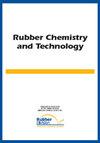THERMALLY CONDUCTIVE DURABLE STRAIN SENSORS FOR NEXT-GENERATION INTELLIGENT TIRES FROM NATURAL RUBBER NANOCOMPOSITES
IF 1.5
4区 工程技术
Q4 POLYMER SCIENCE
引用次数: 1
Abstract
A substantial knowledge gap persists in the material development of smart tires for future self-driving automobiles, which can increase both the vehicles' performance as well as the safety of the passengers. Due to the very high stiffness of conventional strain sensors compared to the softer rubber compound used as the tire tread material, an inaccurate representation of tire deformation characteristics is anticipated. Here, a comprehensive characterization of the electrical conduction and strain sensing behavior of a natural rubber (NR)-based commercial tire tread composite combining the reinforcement of a carbon black-conductive nanofiber dual filler system was carried out for the very first time. The incorporation of as low as 2 wt.% of carbon nanotubes (CNT) and graphite nanofibers (GNF) could increase the electrical conductivity of the control compound by two orders of magnitude compared to the control compound. The gauge factor observed was much higher than the value reported for metallic or polyvinylidene difluoride (PVDF) based stain sensors developed for this application. A 25% enhancement in thermal conductivity was also observed. Thus, the developed composites have the potential to be used as in situ strain sensors so that the problems of debonding and heating differences in the sensor–rubber interfaces in tires can be avoided in future.天然橡胶纳米复合材料下一代智能轮胎用导热耐用应变传感器
在未来自动驾驶汽车智能轮胎的材料开发方面,存在着巨大的知识差距,这可以提高车辆的性能和乘客的安全。由于与用作轮胎胎面材料的较软橡胶化合物相比,传统应变传感器具有非常高的刚度,预计会出现轮胎变形特性的不准确表示。在这里,首次对天然橡胶(NR)基商业轮胎胎面复合材料的导电和应变传感行为进行了全面表征,该复合材料结合了炭黑导电纳米纤维双填料系统的增强。与对照化合物相比,低至2wt.%的碳纳米管(CNT)和石墨纳米纤维(GNF)的掺入可以将对照化合物的电导率提高两个数量级。观察到的应变系数远高于为该应用开发的基于金属或聚偏二氟乙烯(PVDF)的应变传感器的报告值。还观察到热导率提高了25%。因此,所开发的复合材料有潜力用作原位应变传感器,从而避免未来轮胎中传感器-橡胶界面的脱胶和加热差异问题。
本文章由计算机程序翻译,如有差异,请以英文原文为准。
求助全文
约1分钟内获得全文
求助全文
来源期刊

Rubber Chemistry and Technology
工程技术-高分子科学
CiteScore
3.50
自引率
20.00%
发文量
21
审稿时长
3.6 months
期刊介绍:
The scope of RC&T covers:
-Chemistry and Properties-
Mechanics-
Materials Science-
Nanocomposites-
Biotechnology-
Rubber Recycling-
Green Technology-
Characterization and Simulation.
Published continuously since 1928, the journal provides the deepest archive of published research in the field. Rubber Chemistry & Technology is read by scientists and engineers in academia, industry and government.
 求助内容:
求助内容: 应助结果提醒方式:
应助结果提醒方式:


